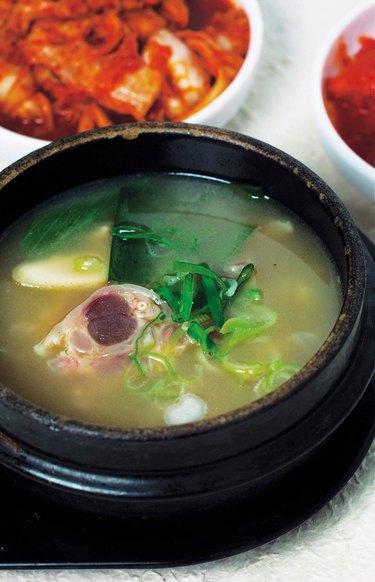Things You'll Need
Heavy-bottomed stockpot
Cold water, stock or broth
Onions
Carrots
Celery
Spoon
Flavoring ingredients, such as garlic, chilis or whole herbs and spices
Cheesecloth
Black peppercorns
Parsley stems
Thyme sprigs
Bay leaves
Sieve
Food-storage container
Cheesecloth
Kitchen twine
Kitchen knife
Plate

Sometimes it's not the ingredients you use in a dish but how you treat them that makes a dish superb. Pig's feet, for example -- which "set foot" on nearly every surface on a farm -- are about as humble as food gets. But when treated with finesse, pig's feet -- also referred to as trotters -- yield some of the most flavorful, silky-smooth meat you'll find on a pig. Slow-cooking the trotters with gelatin- and marrow-filled neck bones produces a full-bodied broth that can stand on its own as a rich soup or as a base for sauces and stews.
Step 1
Place the pig trotters and neck bones in a heavy-bottomed stockpot and add cold water or cold chicken or pork stock. Use a ratio of 1/2 quart of liquid for every 1 pound of trotters and neck bones.
Video of the Day
Step 2
Bring the stock to a low simmer, or about 180 degrees Fahrenheit. Add 1 part mirepoix -- 2 parts chopped onions to 1 part each chopped carrots and celery -- to the stockpot, or 1/2 pound of mirepoix for every 5 pounds of trotters and neck bones.
Step 3
Skim the froth as it accumulates on the surface of the broth using a spoon as it comes up to a simmer.
Step 4
Add pungent and flavorful ingredients to the broth. A few crushed garlic cloves, some chili peppers and a spoonful or two of grains of paradise pairs well to the meatiness of trotters, along with any fresh herbs you prefer.
Step 5
Simmer the broth for about 1 1/2 hours, skimming as needed. Add the delicate fresh herbs and whole spices that wouldn't make it through two hours of simmering. The standard aromatic ensemble of a sachet d'epices -- a few black peppercorns, a palm full of parsley stems, a few sprigs of thyme and a couple bay leaves tied up in a small cheesecloth packet with twine -- is just what you need to finish the broth.
Step 6
Simmer the broth for another 30 minutes and transfer the trotters to a plate. Remove the neck bones, vegetables, herbs and spices and discard them. Strain the broth through a sieve into a food-storage container and let it reach room temperature before placing it in the refrigerator.
Step 7
Pull the bones out of the trotters and discard them when they're cool enough to handle. Slice or dice the meat, picking out any remaining pieces of cartilage or connective tissue as you do so. Set the trotter meat aside on a plate.
Step 8
Add a few spoonfuls of the reserved broth and some freshly chopped herbs along with kosher salt and freshly ground black pepper to taste; mix it with the trotter meat if you want to use it as a topping for a warm salad, crostini, pasta, pizza or any dish that benefits from a flavorful dose of pork.
Step 9
Cook rice, lentils or another absorbent starch using the reserved broth and mix the trotter meat with it to make a dish that takes advantage of both the neck and feet.
Step 10
Use the reserved broth as the base for a sauce, soup or stew and add the trotter meat in the last 15 minutes of cooking, just long enough to heat it through to 165 F. You can also add the trotter meat to the broth and season to taste for a quick soup.
Step 11
Braise other meat dishes using the reserved broth as the braising liquid. Just about any type of braised meat benefits from the addition of pork broth.
Tip
Pig trotters you buy at the market have already been scalded and had the hair removed. However, if you find a stray hair, singe it off with a lighter or torch.
Use the reserved broth within one week.
Video of the Day